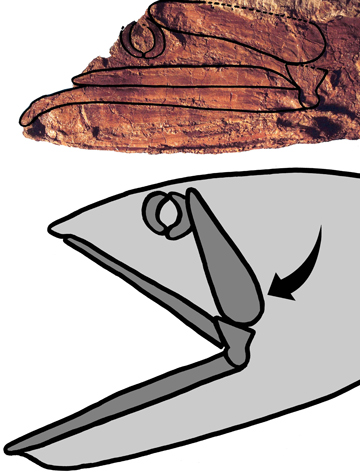Cretaceous Fish with Gigantic Mouths
The oceans of the Cretaceous had some very strange inhabitants, sadly the fossil record only hints at the remarkable diversity of vertebrates, particularly fish. That’s why when scientists announce the discovery of not one but two new species of Cretaceous plankton-feeding fish, such stories tend to make extensive ripples in palaeontological circles. An international team of researchers have announced a tripling of the known fish species that make up the genus called Rhinconichthys (pronounced rink-oh-nik-thees). New fossil discoveries from the United States and Japan extend the known distribution of these Cretaceous fish and it is likely that these types of animals had a global distribution during the Late Cretaceous.
Cretaceous Fish
An Illustration of a Pair of Rhinconichthys Fish Feeding
Picture credit: Bob Nicholls
One of the lead authors of the study, published in the academic journal “Cretaceous Research” Kenshu Shimada, explained that fossils of these types of fish are exceptionally rare. Previously, only one species was known Rhinconichthys taylori, and only two specimens had been described, both from England (dating from the Cenomanian faunal stage of the Cretaceous). However, a new skull from Colorado, along with the re-examination of another skull found in Japan have extended the known palaeogeographical range along with the number of species.
Only Skull Fossils Found
Only the skulls have been found, the cartilaginous skeletons of these fish have a poor fossil preservation potential, a problem that has plagued scientists as they strive to piece together the history of plankton feeding fish. For example, giants are known from the Jurassic such as Leedsichthys and it is very likely that a myriad of forms existed during the Mesozoic, but little fossil evidence has been found with regards to these creatures (Pachycormiformes).
To read more about research into ancient members of the Pachycormidae: Filling a 100 Million Year Wide Gap.
The Colorado fossil was found by Bruce A. Schumacher (United States Forest Service), this species has been named Rhinconichthys purgatoirensis. It dates from later in the Cretaceous when compared to the English fossils (middle Turonian faunal stage of the Cretaceous). R. purgatoirensis swam in the Western Interior Seaway around 89 million years ago, whereas Rhinconichthys taylori lived at least five million years earlier. The Japanese specimen found on the island of Hokkaido, dates from around the same time as the English fossils. It has been named Rhinconichthys uyenoi.
Kenshu Shimada (Department of Environmental Science and Studies, DePaul University, Chicago) stated:
“I was in a team that named Rhinconichthys in 2010, which was based on a single species from England, but we had no idea back then that the genus was so diverse and so globally distributed.”
Rhinconichthys spp.
Rhinconichthys spp. are estimated to have ranged in size from 2 metres to more than 2.7 metres in length. They had a highly specialised jaw with a pair of bones (called hyomanidbulae) that formed a huge oar-shaped lever that enabled the jaws to open extremely wide, a little like the opening mechanism for a parachute. This enabled them to capture even more plankton as they swam. This type of anatomical feature is also found in many types of filter feeding shark today, an example of convergent evolution.
A Picture of the Colorado Specimen Showing Jaw Bones with Explanatory Diagram
Picture credit: DePaul University
Many More Suspension Feeders Existed
Feeding on plankton, being planktivorous, also known as suspension-feeding is seen in a number of specialised aquatic vertebrates today, including the largest animal known to science the Blue Whale (Balaenoptera musculus) and the largest extant fish the Whale Shark (Rhincodon typus). Indeed, the genus name Rhinconichthys means “fish like a whale shark”.
Professor Shimada concluded:
“Based on our new study, we now have three different species of Rhinconichthys from three separate regions of the globe, each represented by a single skull. This tells just how little we still know about the biodiversity of organisms through the Earth’s history. It’s really mindboggling.”
Visit Everything Dinosaur’s award-winning website: Everything Dinosaur.








Leave A Comment